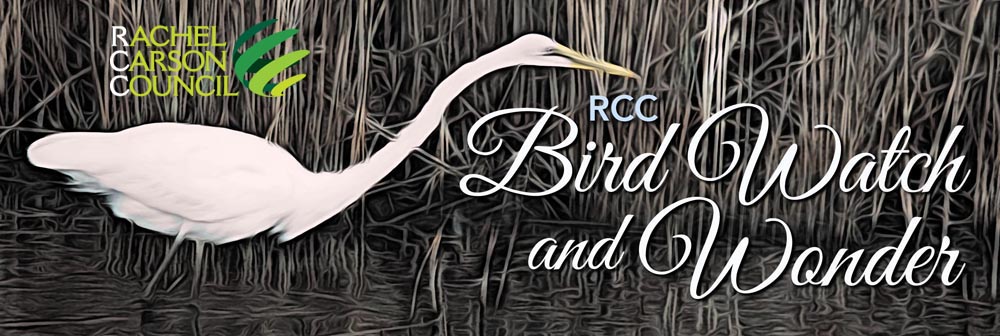 | | | “The more clearly we can focus our attention on the wonders and realities of the universe about us, the less taste we shall have for destruction.” “Those who contemplate the beauty of the earth find reserves of strength that will endure as long as life lasts. There is something infinitely healing in the repeated refrains of nature…” ― Rachel Carson I first sought refuge and solace in nature after the disastrous defeat of Sen. George McGovern by Richard Nixon in 1972. My wife and I headed to the coasts and woods of Maine and Canada. Searching for moose, we discovered instead the beauty and delightful distractions of the birds — first juncos, then warblers, and finally eiders, gannets, puffins, loons. 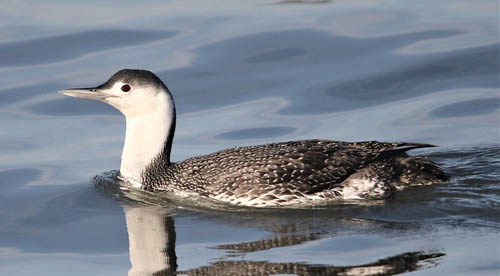 Now January 2025, friends, colleagues, neighbors are seeking such healing (and strength) as Donald Trump reenters the White House with an agenda of dismantling environmental protections, even democracy itself. This time, Caryn and I got out of town as soon as we could. We sought the winter joys of the eastern shores of Maryland and Delaware where, after searching fruitlessly, thousands of honking Snow Geese, in from the Arctic, sought us out and streamed over our heads at Cape Henlopen State Park, hundreds of elegant Canvasback ducks floated calmly at our feet at the edge of Silver Lake, and, in a moment to inspire us for at least the next four years, a Red-throated Loon, also just arrived from the northern wilds of Canada, greeted us at the edge of a stone jetty, dove to find fish then surfaced repeatedly right in front of us as if to show off its skill, its pale winter plumage, or to seek our approval. Now January 2025, friends, colleagues, neighbors are seeking such healing (and strength) as Donald Trump reenters the White House with an agenda of dismantling environmental protections, even democracy itself. This time, Caryn and I got out of town as soon as we could. We sought the winter joys of the eastern shores of Maryland and Delaware where, after searching fruitlessly, thousands of honking Snow Geese, in from the Arctic, sought us out and streamed over our heads at Cape Henlopen State Park, hundreds of elegant Canvasback ducks floated calmly at our feet at the edge of Silver Lake, and, in a moment to inspire us for at least the next four years, a Red-throated Loon, also just arrived from the northern wilds of Canada, greeted us at the edge of a stone jetty, dove to find fish then surfaced repeatedly right in front of us as if to show off its skill, its pale winter plumage, or to seek our approval. And so, this January issue of RCC’s Bird Watch and Wonder is meant to offer you some respite from the drumbeat of news about the newly arrived Trump and Musk era — not to have you give up on the struggle for climate justice, environment and health — but instead to recall again and again the wonders of the universe around us, the brilliance and bravery of birds who survive despite the ills and obstacles our insatiable society has brought upon them, and to offer you strength and spirit for the times that lie ahead. 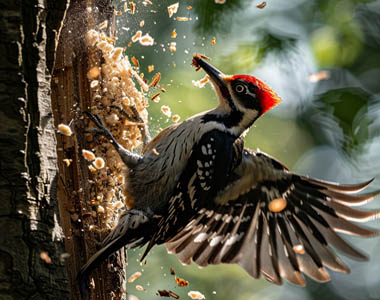 We begin with Ross Feldner’s simple, but brilliant question, “Why Don’t Woodpeckers Get Headaches?” These small creatures constantly pound their heads against wood in order to get food. We get headaches simply watching the news. Woodpeckers have amazing designs in their small bodies adapted for such collisions. Perhaps we humans are not designed for a steady diet of disastrous news and need, instead, to use our more concussion-prone brains to contemplate beauty and the birds. We begin with Ross Feldner’s simple, but brilliant question, “Why Don’t Woodpeckers Get Headaches?” These small creatures constantly pound their heads against wood in order to get food. We get headaches simply watching the news. Woodpeckers have amazing designs in their small bodies adapted for such collisions. Perhaps we humans are not designed for a steady diet of disastrous news and need, instead, to use our more concussion-prone brains to contemplate beauty and the birds.
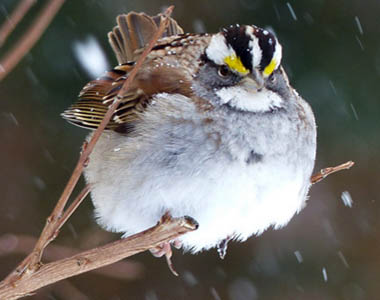 That is what Sabrina Kirby has discovered in a delightful piece in our “Bird Lore” section. Kirby finds joy simply in having other birders point out to her some of the birds she does not often get to see. But she is most enthralled by the bird she only hears, a White-throated Sparrow who sings his familiar, repeated song “Old Sam Peabody, Peabody, Peabody!” Kirby admires Old Sam so much because White-throats are gentler, less aggressive than other birds, especially around feeders, and show the same subtle variations in color patters across both sexes. Turns out in a twist of avian feminism, the males are attracted to females with the white-striped pattern that reveals more aggressiveness, while the females are drawn to males who show the tan stripes that show gentleness. To observe and find out more, Kirby cannot wait to get back to the best birding of all — her own backyard. That is what Sabrina Kirby has discovered in a delightful piece in our “Bird Lore” section. Kirby finds joy simply in having other birders point out to her some of the birds she does not often get to see. But she is most enthralled by the bird she only hears, a White-throated Sparrow who sings his familiar, repeated song “Old Sam Peabody, Peabody, Peabody!” Kirby admires Old Sam so much because White-throats are gentler, less aggressive than other birds, especially around feeders, and show the same subtle variations in color patters across both sexes. Turns out in a twist of avian feminism, the males are attracted to females with the white-striped pattern that reveals more aggressiveness, while the females are drawn to males who show the tan stripes that show gentleness. To observe and find out more, Kirby cannot wait to get back to the best birding of all — her own backyard. Given the polar vortex and the dismal news, many of us will be spending time this winter at our windows at home. Birds are tremendously resourceful and resilient, but you can help them in the cold midwinter by making your own backyard a “Bird Friendly Winter Garden” as our colleagues at the Cornell Lab explain in our “Bird Findings” section. Rachel Carson warned about the arrogance of humans in nature and our need for humility. That’s not hard as we learn more and more about “bird brains.” Seems we could have had a true “stable genius” in the White House had we elected a crow, a species already renowned for its memory, tool making and more, but which now we learn can count out loud up to four! And, in our “Bird Findings” section, you will also be astounded that birds that nest in tree cavities actually choose to line their nests with snake skins in order to ward off predators. 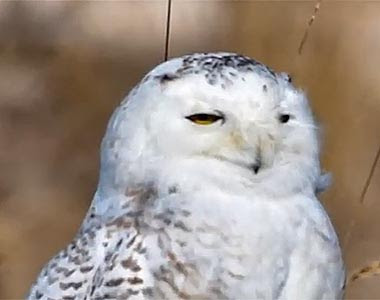 There’s far more in our January issue to keep your awe and imagination, your serenity and strength alive and replenished in this winter of our discontent — from the “Best of Bird of the Week” and the “Best of Momentary Meditations” — where Stephen Shick finds strength in watching a young, female Snowy Owl sitting serenely amidst the freezing winds of Plum Island. There’s far more in our January issue to keep your awe and imagination, your serenity and strength alive and replenished in this winter of our discontent — from the “Best of Bird of the Week” and the “Best of Momentary Meditations” — where Stephen Shick finds strength in watching a young, female Snowy Owl sitting serenely amidst the freezing winds of Plum Island.
Outside of our backyards and bird refuges, the world of pollution and politics still awaits us, as do our efforts to heal it and find hope. But first, may you find, along with us and the inspiration of nature, reserves of strength and healing for the times ahead. | | | | | | | |  Bob Musil is the President & CEO of the Rachel Carson Council and author of Rachel Carson and Her Sisters: Extraordinary Women Who Have Shaped America’s Environment (Rutgers, 2016) and Washington in Spring: A Nature Journal for a Changing Capital (Bartleby, 2016). He is also the editor of the forthcoming annotated edition from Rutgers University Press of Rachel Carson’s Under the Sea-Wind with his Introduction, updated marine science, and historic and contemporary illustrations and photographs. Bob Musil is the President & CEO of the Rachel Carson Council and author of Rachel Carson and Her Sisters: Extraordinary Women Who Have Shaped America’s Environment (Rutgers, 2016) and Washington in Spring: A Nature Journal for a Changing Capital (Bartleby, 2016). He is also the editor of the forthcoming annotated edition from Rutgers University Press of Rachel Carson’s Under the Sea-Wind with his Introduction, updated marine science, and historic and contemporary illustrations and photographs. | | | | | | Why Don’t Woodpeckers Get Headaches? You’d think with all that pecking and drilling and jack-hammering that woodpeckers do in search of food or excavating a nest hole they’d get a concussion or at least feel a little woozy. If you or I did this every day we’d be permanently in the National Football League’s concussion protocol. Wood is tough stuff. That’s why it is commonly used in construction of houses and other structures. The effort required to split or chip away at wood, as anyone who has wielded an axe can attest, demands significant force. | | | | | | | | When Birds Migrated to the Moon From the ancient Greeks to the 17th century, a terrestrial phenomenon baffled scientists: Where did the birds go in winter? Unlike the stars, the moon is close enough for people to envision traveling there. My favorite method of space travel was devised by French writer Cyrano de Bergerac. In his satirical work “A Voyage to the Moon,” published in 1657, he used impeccable logic. Observing that every morning as the Sun rises, dew is drawn upwards in the process of evaporation, he decided to take advantage of this. | | | | | | | | Keeping An Eye On the Sparrow On Seven Mountains Audubon’s October bird walk at Turtle Creek Park near Lewisburg just outside the Pennsylvania Wilds, I was thrilled to spot four birds I wouldn’t have noticed or identified without the help of more experienced birders: a Red-shouldered hawk, a Yellow-rumped warbler, and two Nashville warblers. Always eager to see less-familiar birds, I’m grateful to those who can spot and identify them better than I. But of the thirty species tallied that day, the one that delighted me most was one I heard but didn’t see. | | | | | | | | Bird Friendly Winter Gardens Most of our gardening happens from spring until fall, but what about during those cold winter months? If your plants don’t survive during the frost and snowy season, what do your local birds do? In winter, your residential birds seek out three main ingredients needed for survival: food, water, and cover. While most gardens can provide these in the summer, increasing habitat loss makes things harder for birds during the cold months. | | | | | | | | Science Is Revealing the Social Disparities at the Root of Urban Ecosystems When it comes to biodiversity, research shows not all neighborhoods are created equal. They’re defined by injustices past and present. On a cloudy September morning in Prospect Park, a massive swath of greenery amid Brooklyn’s concrete sprawl, the fall migrants are flying fast and furious. A group of birders spin excitedly in a clearing, calling out as new species appear. “What a hotspot,” says Valentina Alaasam as she scribbles down each name in rapid succession: American Redstart, Scarlet Tanager, Black-and-white Warbler. | | | | | | | | They Were the Last of Their Kind, in Captivity. Can 5 Survive the Wild? Researchers are trying a new strategy to reintroduce Hawaiian crows, which have been extinct in the wild for two decades. When the aviary door swung open, offering the five young birds their first taste of freedom, they took note but stayed put at first, watchful. The glossy black birds are among only about 110 ʻalalā, or Hawaiian crows, left on the planet. Their species has been extinct in the wild for two decades, and previous efforts to reintroduce them have yielded only lessons. | | | | | | | | | | Endangered Hawaiian Birds Find New Home in Kauai Taro Patch A taro patch at Kauai Community College has become a hot spot for endangered Hawaiian birds. Six alae ula, or Hawaiian moorhen chicks, hatched there just this month, and five koloa maoli, or Hawaiian ducklings, also hatched nearby, the college said. Several aeo, or endangered Hawaiian stilts, have also been spotted in the taro patch this year. “Since their habitat is being diminished by poor water management and urban development, it’s good to see these native, endangered species flourish in this area that we are protecting,” said Britton McDaniels. | | | | | | | | Crows Can Count Out Loud, Startling Study Reveals This is the first time an animal other than humans has been seen performing the feat of vocal numeracy. Crows can count out loud, a startling new study has revealed, and they may even have the same numeracy skills as human toddlers. Researchers found that carrion crows (Corvus corone) can produce a specific number of caws in response to visual or auditory stimuli, enabling them to count out loud between one and four. | | | | | | | | Birds Use Snake Skin Decor to Ward Off Predators When a bird drapes its nest with snake skin, it isn't just making an interesting home décor choice. For some birds, it keeps predators at bay. Researchers combined new and historical data to show birds that nest in cavities - covered nests with small openings - are more likely to use shed snake skins in their construction than birds that build open-cup nests, and this practice helps deter predators from eating the eggs. | | | | | | | | Five Years After 3 Billion Birds Lost, Scientists Plan A Road to Recovery After a 2019 study identified major losses to North American bird populations, scientists are working to reverse the declines through pilot projects with Evening Grosbeaks, Lesser Yellowlegs, and others. The word came in a cellphone text from finch researcher Matt Young, who was scouting along a forest road in northern Minnesota’s Sax-Zim Bog: “Grosbeaks coming in!” About a quarter-mile away scientist David Yeany was sitting in a makeshift blind, which was really an insulated ice-fishing pop-up shelter. | | | | | | | | Robotic Pigeon Reveals How Birds Fly Without a Vertical Tail Fin A flying robot uses its bird-like tail to maintain stability in flight – a technique that could enable more aerodynamic aircraft designs that use less fuel A pigeon-inspired robot has solved the mystery of how birds fly without the vertical tail fins that human-designed aircraft rely on. Its makers say the prototype could eventually lead to passenger aircraft with less drag, reducing fuel consumption. | | | | | | | | This Hobby is For the Birds When Luke Safford talks about “birding,” some people hear “burning.” So, Safford calls it “birdwatching.” And he encourages everyone to get out and do it. “We live in this area of the U.S. that’s so unique when it comes to birdwatching,” Safford told 25 guests in early November at the Western National Parks Association in Oro Valley. “Take advantage of it.” Safford, director of engagement for the Tucson Audubon Society, offers nine tips, because “12 is too many,” to enjoy birdwatching. | | | | | | | | Extremely Rare Yellow Northern Cardinal Identified at Michigan Backyard Birdfeeder A yellow northern cardinal is a rare thing and Michigan’s got one. Michiganders Arlene and John McDaniel have been backyard birders for nearly four decades and just before Christmas they noticed something they’d never seen before. There was a yellow northern cardinal near their birdfeeder. | | | | | | | | How Climate Change Threatens This Iconic Florida Bird Because of warmer winters, Florida scrub-jays are now nesting one week earlier than they did in 1981. But these early birds are not always getting the worm. A new analysis of data from a long-term study, published in Ornithological Advances, finds that warmer winters driven by climate change reduced the number of offspring raised annually by the federally threatened Florida Scrub-jay by 25% since 1981. | | | | | | | | Specialist and Migratory Birds at Greater Risk Under Climate Change Following decades of decline, even fewer birds will darken North American skies by the end of the century, according to a new analysis by scientists at the University of Illinois Urbana-Champaign. Their study is the first to examine the long-term effects of climate change on the abundance and diversity of bird groups across the continent as a whole while accounting for additional factors that put birds at risk, such as pesticides, pollution, land use change, and habitat loss. | | | | | | | | Our Favorite Fascinating Bird Behaviors From the 2024 Audubon Photo Awards Birds are always up to something, and these entries captured an array of avians doing everything from impaling prey to drumming away. “To be is to do.” Socrates said that once. Or maybe he didn’t, since the quote has been attributed to many others as well. Birds don’t care about such questions; sometimes they seem content with simply being, but more often they are doing—and doing the most interesting things. | | | | | | | | Orchard Oriole Unlike other orioles the Orchard Oriole sports a deep rust color. Although fairly common they can be inconspicuous poking around shrubs or sitting among the leaves at the top of a tree. It feeds on insects and seeds gleaned from foliage as well as fruit and nectar from (you guessed it) orchards! The male Orchard Oriole sings a chattering, whistled song to attract a mate. It’s whistling is often confused with grosbeaks or robins. The difference is the harsh “churrs” and “chatters” in between the sweeter notes. | | | | | | | | Momentary Meditations are published every Monday to awaken what Rachel Carson called “the sense of wonder” and what Albert Schweitzer called “a reverence for life.” Looking deeply into our interdependence with all life on earth helps us know what we must do. In our harried world, these meditations are meant to serve as a renewable resource for compassion and love. Relentless Wind While I braced myself against the cold and relentless wind on Plum Island, MA, this young, immature female Snowy Owl remained almost motionless. Her confidence invited me to resist my thoughts of returning quickly to my car. | | | | | | | | Enjoy Birdwatching By Going to Festivals A great way to enjoy birdwatching is by going to festivals—they’re organized to get you to well-known birding spots at the right time of year, and they’re a perfect way to meet people. Experts and locals help you see more birds, and you’ll meet other visitors who share your hobby. While you’re there, keep an eye out for Cornell Lab representatives, as we do attend several festivals each year. | | | | | | | | One Wild Bird at a Time: Portraits of Individual Lives 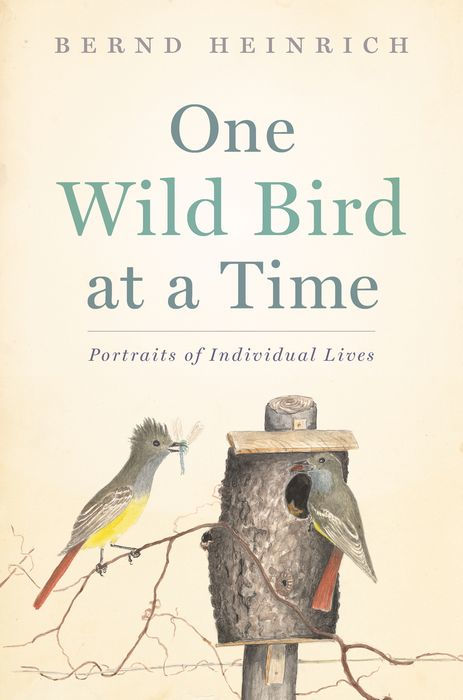 Unique encounters with wild birds from the acclaimed scientist and “a dedicated watcher happy to knock down the fourth wall of zoology” (The Wall Street Journal). Unique encounters with wild birds from the acclaimed scientist and “a dedicated watcher happy to knock down the fourth wall of zoology” (The Wall Street Journal).
In his modern classics One Man’s Owl and Mind of the Raven, Bernd Heinrich has written memorably about his relationships with wild ravens and a great horned owl. In One Wild Bird at a Time, Heinrich returns to his great love: close, day-to-day observations of individual wild birds.
There are countless books on bird behavior, but Heinrich argues that some of the most amazing bird behaviors fall below the radar of what most birds do in aggregate. Heinrich’s “passionate observations [that] superbly mix memoir and science” lead to fascinating questions—and sometimes startling discoveries (The New York Times Book Review). A great crested flycatcher, while bringing food to the young in their nest, is attacked by the other flycatcher nearby. Why? A pair of Northern flickers hammering their nest-hole into the side of Heinrich’s cabin deliver the opportunity to observe the feeding competition between siblings, and to make a related discovery about nest-cleaning. One of a clutch of redstart warbler babies fledges out of the nest from twenty feet above the ground, and lands on the grass below. It can’t fly. What will happen next? Heinrich “looks closely, with his trademark ‘hands-and-knees science’ at its most engaging, [delivering] what can only be called psychological marvels of knowing” (The Boston Globe). “An engaging memoir of the opportunities for doing scientific research without leaving one’s own backyard.”—Kirkus Reviews Click here to purchase | | | | | | | | The January 2025 issue of Bird Watch and Wonder was produced by Ross Feldner | | | |  The Rachel Carson Council Depends on Tax-deductible Gifts From Concerned Individuals Like You. Please Help If You can. The Rachel Carson Council Depends on Tax-deductible Gifts From Concerned Individuals Like You. Please Help If You can. | | | |  Sign Up Here to Receive the RCC E-News and Other RCC Newsletters, Information and Alerts. Sign Up Here to Receive the RCC E-News and Other RCC Newsletters, Information and Alerts. | | | | | | | | | | | |